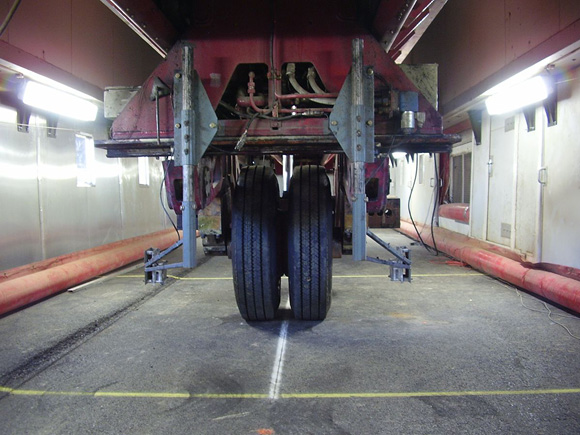What is Accelerated Pavement Testing?
by Andrew Lees, on November 02, 2022
What is Accelerated Pavement Testing (APT)?
Accelerated Pavement Testing is a means of determining long-term pavement performance, in a reduced timescale. It involves the application of realistic wheel loading to a layered pavement structure, simulating long-term in-service traffic loading conditions in a collapsed time period, in order to determine the pavement response and performance.
In this Ground Coffee blog, you can find out about:
- How is an accelerated pavement test carried out?
- What is a heavy vehicle sumulator (HVS)?
- What is measured in an APT?
- Why is full scale testing important?
- What can we learn from APT testing?
- How does Tensar use APT testing?
How is an accelerated pavement test carried out?
APT testing can be carried out on a test track using actual vehicles or using specialised equipment incorporating a load frame capable of applying moving wheel loading in a linear or circular arrangement. The load frames can be positioned over an actual pavement section, or - more commonly - set up over pavement sections constructed in a specialist test facility. The advantage of the specialist test facilities is that conditions can be carefully controlled to minimise the number of variables.

APT testing in progress using a reciprocating dual wheel tandem axle
What is a heavy vehicle simulator (HVS)?
The heavy vehicle simulator is one form of linear wheel loading frame that applies multiple wheel passes on full-scale pavement sections. The unit is mobile, allowing it to be shifted and re-located over real pavements or test sections. Some HVSs incorporate environmental chambers to control pavement temperature and moisture as well as allowing variations in loading and wheel wander.
What is measured in an APT?
Pavement surface deformation is monitored along the length of the test section throughout the test. In specialist facilities, strain gauges, pressure sensors and moisture gauges may be incorporated at various depths within the pavement. Detailed measurements of pavement layer thickness and profile will be made during construction and after testing is complete, to reveal permanent deformation in the layers and the subgrade surface.
Why is full scale testing important?
The performance of a pavement and its ultimate failure result from the accumulated damage caused by multiple wheel passes on each of the pavement layers. It is not possible to determine pavement life by examining the performance of a single layer or material in isolation. APT testing is the only way to realistically determine long term performance and life of the full pavement structure.
What can we learn from APT testing?
By monitoring the surface deformation in an APT we can predict the life expectancy of a pavement structure. By observing crack patterns in the asphalt and measuring changes in pavement layer thicknesses we can examine the performance and failure mechanism of specific pavement layers.
APT testing in specialist facilities is an excellent way to compare the long-term performance of alternative pavement systems or materials under identical controlled conditions.
How does Tensar use APT testing?
Tensar has its own small scale APT test rig that is used for product development purposes. It allows comparisons to be made, of the effect of structural or material changes to different geogrids in a test pavement structure.
.jpg)
Titan heavy vehicle simulator equipped with environmental chamber at US Army Engineer Research & Development Centre in Vicksburg
To determine real life performance and develop design parameters for pavement design incorporating Tensar geogrids, Tensar uses full scale APT testing carried out at specialist APT facilities. Testing of Tensar InterAx geogrid in flexible pavements is ongoing at the US Army Engineer Research and Development Centre (ERDC) in Vicksburg. The ERDC’s recently acquired ‘Titan’ heavy vehicle simulator has been used to test asphalt-surfaced full depth pavements sections incorporating Tensar InterAx geogrid stabilised base layers.
The Titan HVS has a wheel travel span of 23m and is capable of applying 9000 passes of a dual wheel tandem axle per day.
Data from the testing will be used to validate Tensar InterAx geogrid specific design parameters incorporated into Tensar’s pavement design software, Tensar+.
You can access Tensar+ here: Tensar+ | A Better Way to Build™ (tensarplus.com)



-(1).png?width=400&height=400&ext=.png)